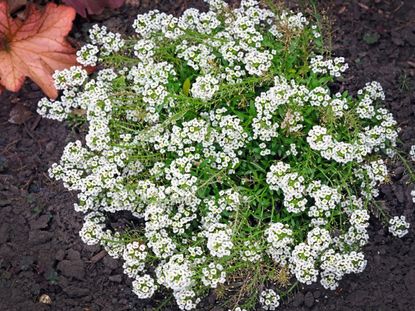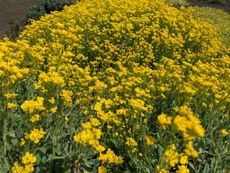Sweet Alyssum Flowers - Tips For Growing Sweet Alyssum


Few annual plants can match the heat and drought hardiness of sweet alyssum. The flowering plant has naturalized in the United States and thrives in a wide range of regions.
Sweet alyssum flowers are so named for their lively fragrance and are members of the mustard family. While not frost-tolerant, sweet alyssum plants will self-sow and can provide you with year after year of bright color in milder climates.
Sweet Alyssum Plants
Sweet alyssum flowers (Lobularia maritima syn. Alyssum maritimum) are useful in alpine rock gardens, borders, planters, hanging baskets, and dry zones. They are small plants that may get 3 to 6 inches (7.5 to 15 cm.) tall and produce clusters of tiny flowers in clumps. T
he blooms come in pink, salmon, purple, white, and yellow. Flowers arise from June to October and can be encouraged to rebloom by cutting back spent flowers.
How to Grow Alyssum
Growing sweet alyssum requires well-drained soil with moderate moisture. The plants are tolerant of many types of soils and make a cheerful accent in many situations. Start from seed in early spring in seed flats indoors and transplant after the danger of frost has passed.
Surface sow the tiny seed and keep lightly moist until germination, which is usually 15 to 20 days. When the seedlings have several pairs of true leaves and soil temperatures are at least 60 F. (16 C.) degrees, transplant them into a prepared garden bed.
Learning how to grow alyssum is easy and a packet of seeds is cheaper than purchasing bedding plants.
Gardening tips, videos, info and more delivered right to your inbox!
Sign up for the Gardening Know How newsletter today and receive a free download of our most popular eBook "How to Grow Delicious Tomatoes."
How to Plant Alyssum
Learning how to plant alyssum is easy. You can also plant sweet alyssum flowers from seed straight into the garden in mild climates. Choose a location that has full sun, although sweet alyssum plants can tolerate partial shade as well. Prepare the soil prior to planting by weeding, working in organic amendments, and raking out any obstructions.
Before transplanting your seedlings, check the drainage in your soil by digging a hole and filling it with water. If soil doesn't drain quickly, work in compost, leaf litter, or grit, such as sand, to increase the porosity of the soil. Keep the bed weed-free to reduce competition for resources and provide even moisture.
Sweet Alyssum Flower Problems
Sweet alyssum plants require little maintenance. While alyssum is relatively maintenance-free, it will do poorly on boggy sites and where inadequate moisture is provided.
It is prone to few pest problems but may get stem rot or leaf blight where too much shade prevents the leaves and soil from drying out. Botrytis blight is a particular problem of sweet alyssum plants when they are grown in overly wet areas. Trim back the stems after blooming for an endless display of colorful, sweet alyssum flowers.

Bonnie Grant is a professional landscaper with a Certification in Urban Gardening. She has been gardening and writing for 15 years. A former professional chef, she has a passion for edible landscaping.
-
 How To Grow Garden To Table: A Guide For Home Cooks
How To Grow Garden To Table: A Guide For Home CooksWhat could be better than a meal that comes directly from garden to table? Show off your gardening and culinary skills with the very freshest food.
By Bonnie L. Grant
-
 Want a Backyard Mini Orchard? Create Your Own Container Orchard
Want a Backyard Mini Orchard? Create Your Own Container OrchardEasier to care for in small spaces, a backyard mini-orchard makes sense for busy gardeners and juicy fruit is the reward.
By Teo Spengler
-
 Potted Alyssum Plants: Growing Sweet Alyssum In A Container
Potted Alyssum Plants: Growing Sweet Alyssum In A ContainerDespite its looks, sweet alyssum is a tough, easy-to-grow plant that is adaptable to various conditions. Its trailing, creeping habit makes it perfect for growing in a container. For information on container growing sweet alyssum plants, click here.
By Mary H. Dyer
-
 How To Grow Mountain Alyssum - Mountain Alyssum Care And Growing Conditions
How To Grow Mountain Alyssum - Mountain Alyssum Care And Growing ConditionsIf you are looking for an evergreen perennial ground cover, look no further than the mountain alyssum plant. Keep reading this article to find out more about this interesting plant.
By Amy Grant